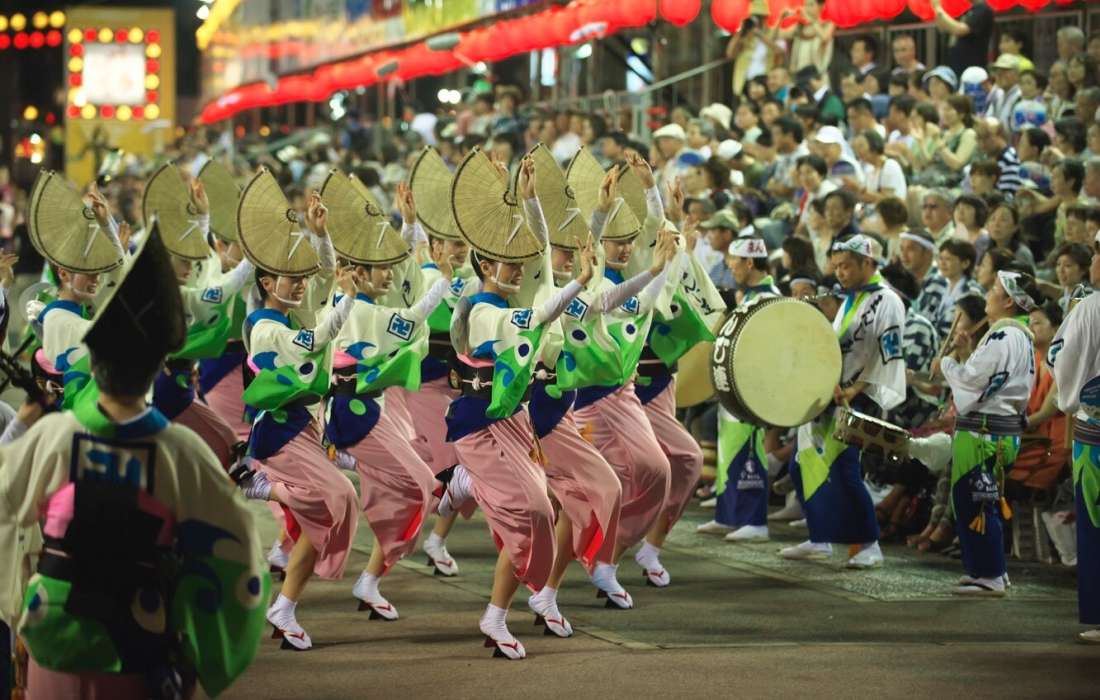Vibrant summer matsuri are some of the best places to experience traditional Japanese music.
If you thought Japan’s outdoor music festivals started with Fuji Rock, think again. For centuries, this has been a season for people to come together and dance to pounding rhythms and hypnotic melodies at summer matsuri (festivals). Rooted in the traditions of Obon, when people honor the spirits of their ancestors, these events can be a feast for the eyes—but they are also some of the best places to hear traditional music in Japan.
Awa Odori: The summer festival that’s Japan’s answer to the Rio Carnival (Tokushima)
Over a million tourists descend on Tokushima each year for one of the greatest of Japan’s summer festivals. The Awa Odori has been going strong for over 400 years, despite repeated efforts by authorities to ban it in centuries gone by. Groups of dancers and musicians parade through the streets, performing choreographed routines to the sounds of taiko drums, flutes, shamisen and piercing bells.

Dancers from the Manji-ren troupe perform at Tokushima’s Awa Odori (Photo credit: Tokushima Prefecture Tourism Association)
The music is based around a lively two-beat rhythm known as zomeki, though you’ll occasionally hear a trace of samba, confirming this as Japan’s rival to the carnival of Rio de Janeiro.
Gujo Odori: The matsuri that keeps going until dawn (Gifu)
While most of Japan’s summer festivals finish at a respectable hour, this one keeps on going. The Gujo Odori runs from July through September, but during a four-night stretch in mid-August the communal dancing continues until 4am.

There are ten dances in all, each with their own song, and you’ll have more fun taking part than just watching. The singers and musicians perform from inside a float in the center of town, and while some pieces have full instrumentation, others are sung just to a drum beat, or a cappella.
Nishimonai Bon Odori: Dancing with the spirits of the dead (Akita)
The graceful movements of the Nishimonai Bon Odori are one of Japan’s furyu odori, traditional folk dances with spiritual roots that have been recommended for inclusion in the UNESCO Intangible Cultural Heritage list. Believed to date back to the 13th century, the event is an atmospheric affair.

The mysterious dancers of the Nishimonai Bon Odori (Photo credit: Ugo Town Office)
Dancers perform with their faces concealed behind woven hats or black hoods to represent the spirits of the departed. The music, by contrast, is often more uptempo, with shamisen, flutes, drums and some occasionally boisterous vocals.
Yao Kawachi Ondo: Epic storytelling to a hypnotic beat (Osaka)
An industrial city on the outskirts of Osaka was the birthplace of kawachi ondo, a freeform folk song in which singers deliver epic stories that can last over half an hour. At the annual Yao Kawachi Ondo Festival, locals dance together while vocalists perform their sprawling songs to the accompaniment of a lone taiko drum, shamisen, electric guitars, and call-and-response backing vocals. The rhythm has a lilting bounce, which may explain why some artists have spliced it with reggae in the past.

Lanterns and traditional song light up the evening at the Yao Kawachi Ondo (Photo credit: Courtesy of Yao City)
Kiryu Yagibushi: Japanese traditional song and partying in the streets (Gunma)
Few of Japan’s folk songs are as infectious as yagibushi, in which the driving rhythm periodically pauses to let a solo singer belt out the soaring melody. Native to Gunma and Tochigi prefectures, it was the inspiration for the relatively young Kiryu Yagibushi Festival, which started in 1964.

Crowds pack the streets for the climax of the Kiryu Yagibushi (Photo credit: Kiryu Yagibushi Festival Supporters’ Association)
The three-day event includes a competition for yagibushi singers from across Japan, and culminates with a communal dance in the city center that can feel more like an enormous summer block party.
Note
Due to the COVID-19 situation, Japan’s summer festivals are having to do things differently this year. The Awa Odori and Gujo Odori will be going ahead, albeit on a smaller scale. The Nishimonai Bon Odori is being held without spectators, but will be streamed online. Most of the events of the Kiryu Yagibushi have been cancelled, and the Kawachi Ondo won’t be happening this year.
-
About the author
Author: James Hadfield
Profile: Originally from the UK, James Hadfield has been living in Japan for nearly 20 years and still hasn’t got bored. He writes about lifestyle and culture for publications including The Japan Times and ele-king.





















































